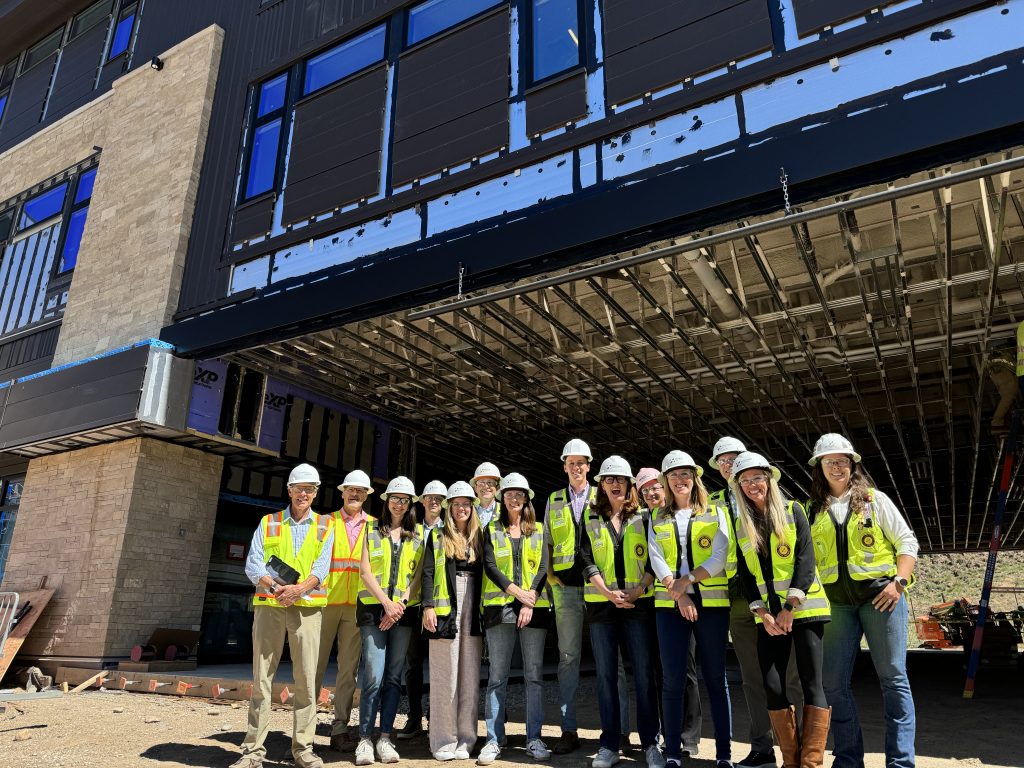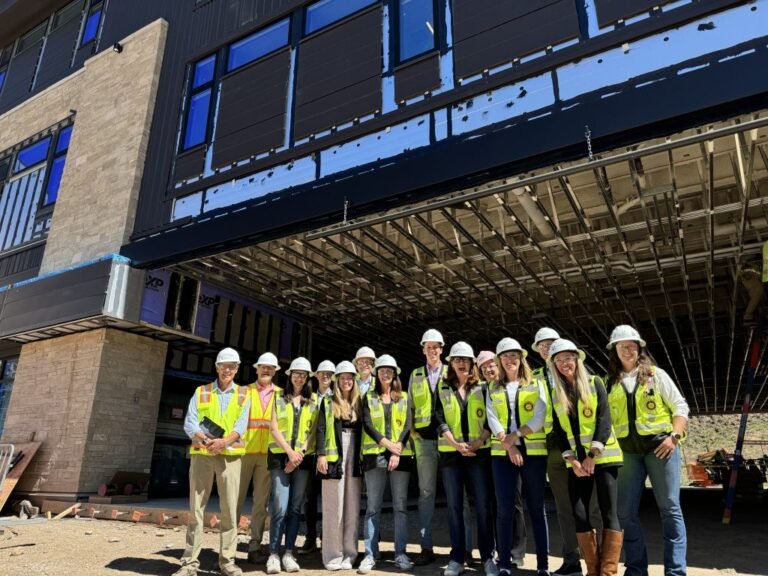
Vail Health/Photo courtesy
Colorado House Speaker Julie McCluskey, Sen. Dylan Roberts and Rep. Megan Lukens toured Wiegers Mental Health Clinic and Precourt Healing Center in Edwards on Monday.
Western Slope councillors were given a tour of the Precourt Healing Centre, currently under construction. The tour began at the ambulance bay and was taken through each of the patient areas: reception, kitchen, pharmacy, gym, outdoor space, patient rooms, group and art therapy rooms, isolation rooms and visitor rooms.
Construction on Precourt Healing Centre is expected to be completed in the next few months, with the facility expected to open in mid-May 2025. The facility will be three stories and have 28 beds, all private rooms with individual bathrooms.
The first floor of the facility will be the reception area, while the second and third floors will be housing and living areas for inpatients.
Currently, the second floor is designated for adolescent care and the third floor for adult care, but the facility allows for “flexible” arrangement of rooms between the units and the ability to swap adult or adolescent capacity for the other seven beds if necessary. Staff-to-patient ratios will vary for adults and adolescents, but hiring for the new facility will be done based on the most conservative standards, said Casey Wolfington, Vail Health’s director of community behavioral health.

Support local journalism
Precourt Healing Center has several unique features aimed at promoting patient-first care.
Each inpatient floor is divided into two mirrored halves, with seven beds on each side. For the most part, floors are open to allow patients to move freely. There are staff-only areas in the center of each floor, and while some areas are off-limits to patients, a central staff hub allows staff to move from one side of the facility to the other.

Once open, the center will accept patients from throughout the region and treatment will no longer be limited to Eagle County or Colorado residents, and health care workers will be able to follow patients back and forth between inpatient and outpatient facilities.
“Personally, when I see patients coming in, the first thing they say is, ‘Oh, it’s so much worse in here than it is outside, so I’ve got to say whatever I need to just get out,'” Wolfington said. “We don’t want them to feel like they have to go home. We don’t want to rush their recovery.”
Both floors of the inpatient facility are designed with an open concept.
“When most people think of an inpatient facility, they think of a small room with a bunch of chairs, a TV in the corner, and they just sit there all day,” Wolfington said. “We wanted to make sure patients had lots of opportunity to make individual choices about where they were and how they were cared for, and we wanted to make sure they were comfortable.”
Each inpatient floor has an outdoor social space, with tents to provide shade in the summer and a supply of melted snow water in the winter, so patients can enjoy fresh air all year round.
Window, separate bathroom, bed
“Typically, to be safe, they say you can’t create a room that exudes comfort, but I think we’ve completely changed that,” Wolfington said.
Precourt Healing Center will be the second facility in the U.S. to install OxiHealth, an infrared scanner that measures a patient’s temperature footprint, pulse rate, respiratory rate and more — a convenient way for facility staff to avoid waking patients when they need to check on them at night.
The facility has one isolation room on each floor, which is required by the state for behavioral health facilities, but Wolfington said he never wanted to use the space for that purpose.
“We’re hopeful that if we can create a strong enough plan and it’s utilized, we can show the BHA (Behavioral Health Administration) that isolation rooms may not actually be necessary,” Wolfington said.
During their stay at Precourt Healing Center, patients receive seven to nine hours of therapeutic support per day, ranging from art therapy to movement therapy to traditional talk therapy.
Alternative therapy rooms, such as the Art Room, are located on the same floor as patient rooms, making it easy for patients to receive treatment if the need arises at unscheduled times.
The kitchen will serve healthy, nutritious meals and there will be an on-site gym where patients can work out regularly, with staff providing instruction on how to exercise — features that, among others, are priorities for Vail Health Behavioral Health Executive Director Chris Lindley.
Visiting rooms for family members, attorneys, etc. are located outside the patient’s living area. Visiting hours are flexible to accommodate busy schedules of mountain families.
Innovation at Wigger Mental Health Clinic
The Precourt Healing Center isn’t the only change coming to Vail Health Behavioral Health: Wigger Mental Health Clinic is also set to undergo renovation and expansion soon.
The clinic is currently located in one block of a large building on Edwards, but will soon be taking over the rest of the building to provide nine more clinical office spaces.Currently, the behavioral health team is not in an office at all.
The Vail Health Behavioral Health Innovation Center and behavioral health research team will soon be located in the same building as the clinic. The research team has already begun studying the effects of heat therapy on depression, and will soon be adding psilocybin research.

Funding and staffing new and expanded Vail Health Behavioral Health facilities
The Vail Health behavioral health team is “trying to create a new model for providing care and financing it,” Vail Health CEO Will Cook told visiting lawmakers on Monday.
Precourt Healing Center is expected to employ a total of 178 people.
McCluskey asked how Vail Health would fund the project without creating new payment barriers for patients.
“When we don’t invest enough in what I call primary care, preventive care, which is the least effective and most expensive way of paying for it, which is emergency departments and inpatient facilities, there’s a lot of waste in the health care system,” Cook said.
Cook said Vail Health aims to reallocate funds to places where they can be more effective, such as schools or primary care physicians, rather than ignoring a potential patient’s mental health until they hit a $25,000 emergency room bill.
Vail Health is negotiating with private insurers to ensure payment parity for private care, and the behavioral health facility will also accept Medicare and Medicaid.
Want the news delivered to you? Get the top stories delivered to your inbox every morning. Sign up here: VailDaily.com/newsletter
To attract so many employees, they need places to live, and Cook stressed the need to build housing like Fox Hollow, including by participating in public-private partnerships.
Retaining current staff is another piece of the puzzle: Wolfington said health care workers often take jobs at community mental health centers prepared to quit, a trend he has tried to counter at Vail Health Behavioral Health.
“Since we started in 2020, we’ve had one provider leave,” Wolfington said. “I think a lot of community mental health centers are losing providers because they’re putting providers on more and more caseloads, putting them in more serious situations that they’re not trained to handle, and not giving them the support. So our goal is to give providers a way to see patients so they don’t have to go into private practice to make money.”


